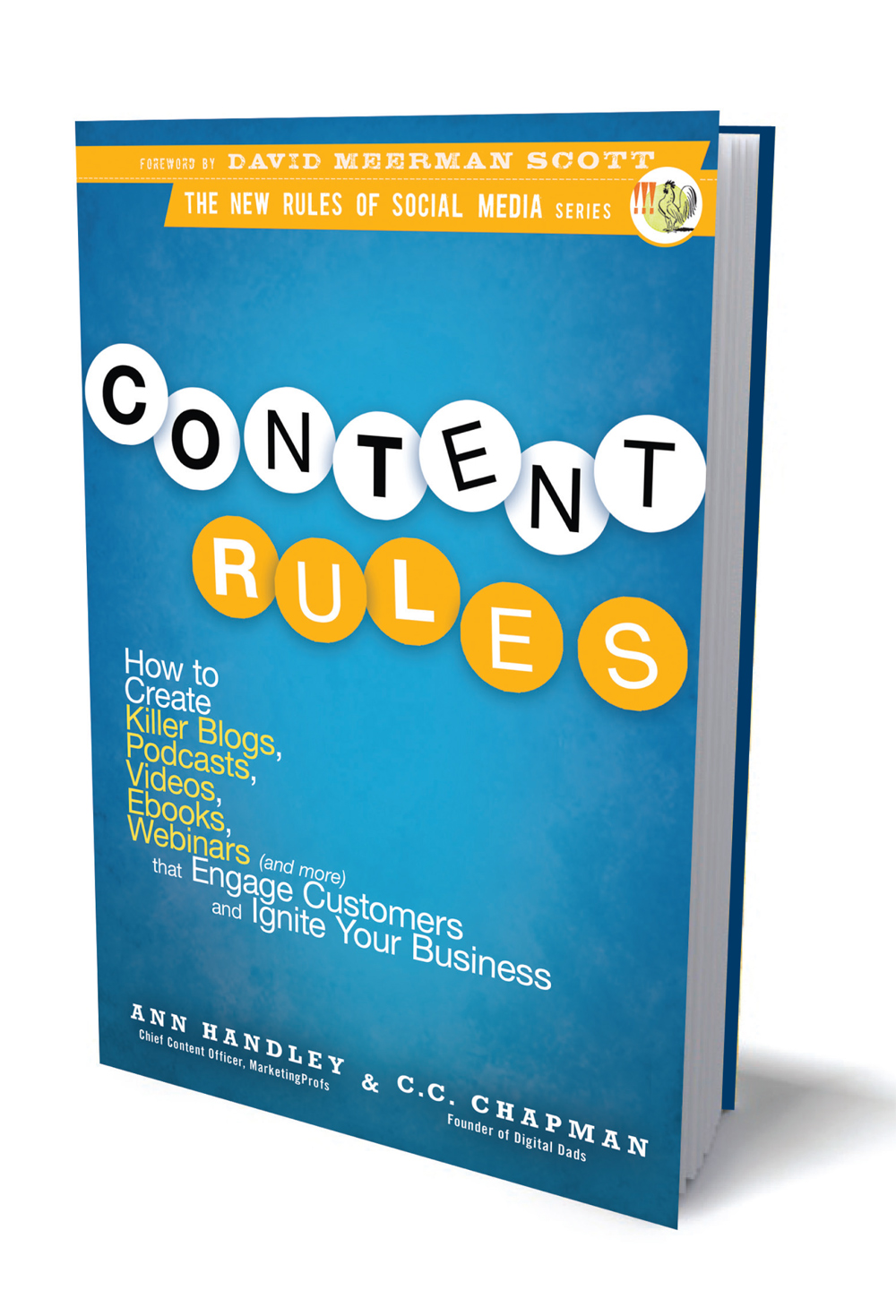The new book Content Rules fills that void by providing a roadmap on how to create content that engages customers and prospects. Filled with real-world examples and usable insights, the book provides specific business cases for both BtoB and BtoC marketers. In addition, the book provides specific insights into how content can and should be used to drive demand generation programs.
With that in mind, DemandGen Report recently connected with Content Rules co-author Ann Handley to discuss topics such as marketing metrics, the content circle of life and the role of emerging, interactive content mediums. Highlights of that discussion are included here:
DemandGen Report: In the chapter titled “Insight Inspires Originality,” you talk about the importance of setting metrics so that marketers know what success looks like. Is this new way of thinking still a challenge for marketers? And for marketers that are new to content marketing, how should they initially set their expectations for things like downloads of E-books or attendees at a webinar?
 Handley: I think the smartest BtoB marketers are already setting metrics and measuring the effectiveness of their marketing. Part of that is about establishing accountability — because marketers are looking to create credibility with the C-suite. But it’s also about the explosion of tools and channels, and discerning what’s working best out of all the options in a business’s toolshed.
Handley: I think the smartest BtoB marketers are already setting metrics and measuring the effectiveness of their marketing. Part of that is about establishing accountability — because marketers are looking to create credibility with the C-suite. But it’s also about the explosion of tools and channels, and discerning what’s working best out of all the options in a business’s toolshed.
It’s hard for me to give you a benchmark as to the expected number of downloads or seats reserved at a webinar, or other kind of interactive content offering. The only useful benchmark is truly the one you set for yourself. With content marketing, the idea is to continually improve results, and tie them more accurately to business goals. So if you are using a webinar featuring an industry thought-leader as a lead generation tool — you might measure the success of your program around not just signups but also the number of people who attended, the number who accessed it on demand after the live event, and ultimately the number of those people with whom you furthered a relationship: How many agreed to a demo, for example, and then bought your product or service? (How many converted?)
DemandGen Report: As part of the “Anatomy of a Content Circle of Life,” you talk about the Content Food Chain where a single Big Idea can feed an overall content plan. Can you provide some examples of how that works and expand on the concept of the Content Circle of Life for our readers?
Handley: Absolutely. A great real-world example is Kinaxis, a supply chain management company. Kinaxis focuses its content development efforts on a single “big idea” each month and from that it generally produces a large content asset — say, a white paper or E-book. It then uses that content asset to spin off other assets — in some cases “reimagining” that content (to use a word we use in Content Rules to describe the concept of re-inventing the same content in various ways, across various platforms). So Kinaxis might use the white paper as the basis for a few blog posts, or it might create a webinar based on a few of its themes, or it might interview the author of it in a podcast or video or both.
You get the idea, right? Create 10 things out of 1 thing — both by creating a content “chop shop” (by lopping off things to stand alone in the blog or on your Facebook page or in your Twitter feed) as well as “reimagining” content (by creatively thinking of how else you might express similar ideas in different ways, in various formats).
DemandGen Report: One of the more interesting chapters was “Share or Solve,” where you reinforce the message that content marketing should not focus on sales messages. This chapter also gives some great ideas for developing content, even when there is seemingly “nothing to say.” Can you expand on the premise of Share or Solve and maybe share a few of the tips on What to Talk About When There Is Nothing to Say?
Handley: The inherent tension in marketing is that businesses always want to talk about their products or services. Meanwhile, your customers only want to hear what your products or services will do for them. That seems like a simple idea, right? A no-brainer? Except most businesses are terrible at really grokking what that means: Share a resource or solve a problem for your customers, help them do their jobs better; don’t just talk about your stuff.
In other words, good content doesn’t try to sell. Rather, it creates value for your customers (or would-be customers) by positioning you as a reliable and valuable source of information. As we say in the book, “Your content shares a resource, solves a problem, helps your customers do their jobs better, improves their lives, or makes them smarter, wittier, better-looking, taller, better-networked, cooler, more enlightened, and with better backhands, tighter asses, and cuter kids. In other words, it’s high value to your customers, in whatever way resonates best with them.”
American Express does this really well with its OPEN Forum (openforum.com) website. OPEN Forum is a resource for small business owners, and the articles and videos and ideas there transcend American Express specifically. But it positions AmEx as a trusted source. American Express sees the value of putting Content and Context before Selling.
So does Citrix: It’s Workshifting.com blog is a place where “workshifters,” or people who work outside of a traditional offices, can share ideas and just hang out. Citrix sells technology, but its content creates a resource and shares ideas with people who work in their jammies. It focuses on how people use the technology, right? Not the technology itself.
So on a smaller scale: What do you talk about when there’s nothing to say? When you aren’t sure how to embody that ideal in your own content? There’s a zillion ways, but here are a few: The easiest thing to do is just talk to your customers — ask them what challenges they face, and then use your blog to answer those questions. Also: Monitor the queries your customers are searching on to see what they are searching for that you aren’t answering — we borrow a phrase from John Jantsch and call those FUQs — or Frequently Unasked Questions. Interview big shots in your industry. Arm your sales team with Flip cameras and set them loose on a trade show floor. Solicit feedback on an issue via social channels like Twitter or Facebook or LinkedIn, and then turn that into a post or a series of posts.
I could spend all day tossing out ideas, but I’ll stop here for the sake of brevity…!
DemandGen Report: There is a chapter in the book that speaks specifically to the content needs and challenges of BtoB marketers. Can you talk about some of the unique nuances of BtoB and why content strategies need to specifically address those nuances?
Handley: What’s funny is that our editor at Wiley wasn’t thrilled about including a separate BtoB chapter. But because MarketingProfs has such a huge BtoB readership, I know that BtoB companies often see themselves differently, and see themselves as having unique challenges.
To some degree, that’s true: BtoB companies definitely have more complex, longer sales cycles. And because so many of their buyers are doing their homework online before a purchase — querying search engines and their social networks — buyers typically don’t reveal themselves until much later in the sales cycle than they used to. So that means a BtoB company’s content is under a lot of pressure to attract and nurture prospects — a role that used to be filled by actual human beings (salespeople).
Also, that means BtoB companies have to consider some things BtoC companies may not: Do we gate our content behind a registration wall, or do we let anyone download it for free? How do we create momentum with our buyers, engaging with them through the various stages cleanly and efficiently? Is our mindset one of lead generation only, or are we developing a content strategy to keep people engaged until they are ready to talk to our sales reps? Is our content answering the questions they have along the path to conversion? Or are we losing them?
That said, the concepts and content “rules” we talk about in the other (non-BtoB-specific) chapters of the book also apply to BtoB companies — a point we make clear in the book. And to tell you the truth, I don’t think BtoB companies are as radically different as they often see themselves. In the end — in a BtoB or BtoC scenario — business is still about people selling to people, right? The focus is still on creating quality content, not quantity. And very often, what’s “compelling” content is compelling, period, because it appeals to other humans.
DemandGen Report: In addition to traditional content offers like white papers and E-books, Content Rules also offers deep dive insights into video and podcasts as content mediums. Do you see interactive media playing a bigger role in content strategy moving forward?
Handley: For sure. Video, in particular, is increasingly playing a bigger role in a company’s content. In part that’s because the technology and tools have evolved to the point where it’s both easy and cheap to create a fun, simple video. But it’s also because video is so inherently compelling a medium — a company can show how its products or services live in the world in a very tangible way — and also because video content is 50 times more likely to appear on the first page of search results than standard text-based content, according to a recent Forrester report.
So the short answer is… yes. And I say this as a writer and editor, as someone who has an inherent bias toward (and love of!) print and text.
Demand Discussion: How is your organization exploring content marketing for demand generation?







